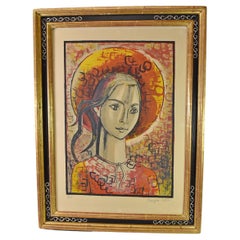Aurelia In A Red Bonnet
Recent Sales
Francoise Gilot, "Aurelia with a Red Bonnet", Lithograph, 1971
By Françoise Gilot
Located in Toledo, OH
Francoise Gilot, "Aurelia with a Red Bonnet", Lithograph. Circa 1971. Aurelia is Gilot's daughter
Category
Late 20th Century Prints
Materials
Paper
Get Updated with New Arrivals
Save "Aurelia In A Red Bonnet", and we’ll notify you when there are new listings in this category.
More Ways To Browse
Jonathan Adler Talitha
Jonathan Burden
Jonathan Nesci 4g
Jorge Zalszupin Bar Cart
Jorge Zalszupin Cart
Jorge Zalszupin Presidencial
Jorgen Lund
Josef Frank Flora Cabinet
Josef Hoffmann Flower Stand
Joseph Karl Stieler
Joseph Magnin Ceramic
Josiah Spode On Sale
Juan Luna
Jules Graux
Junghans Ato
Juno Sculpture
Just Andersen Bird
Juzu Beads
